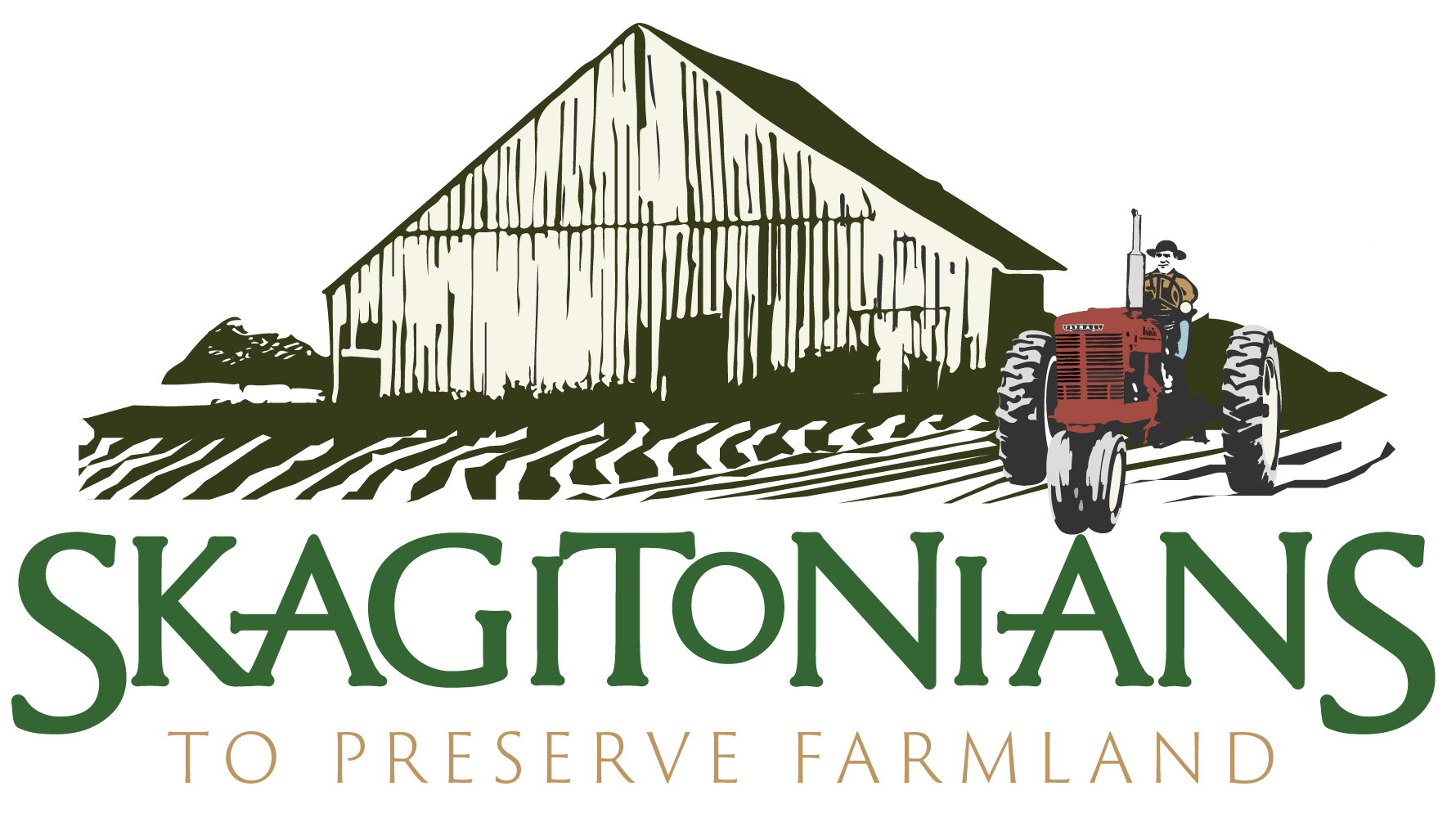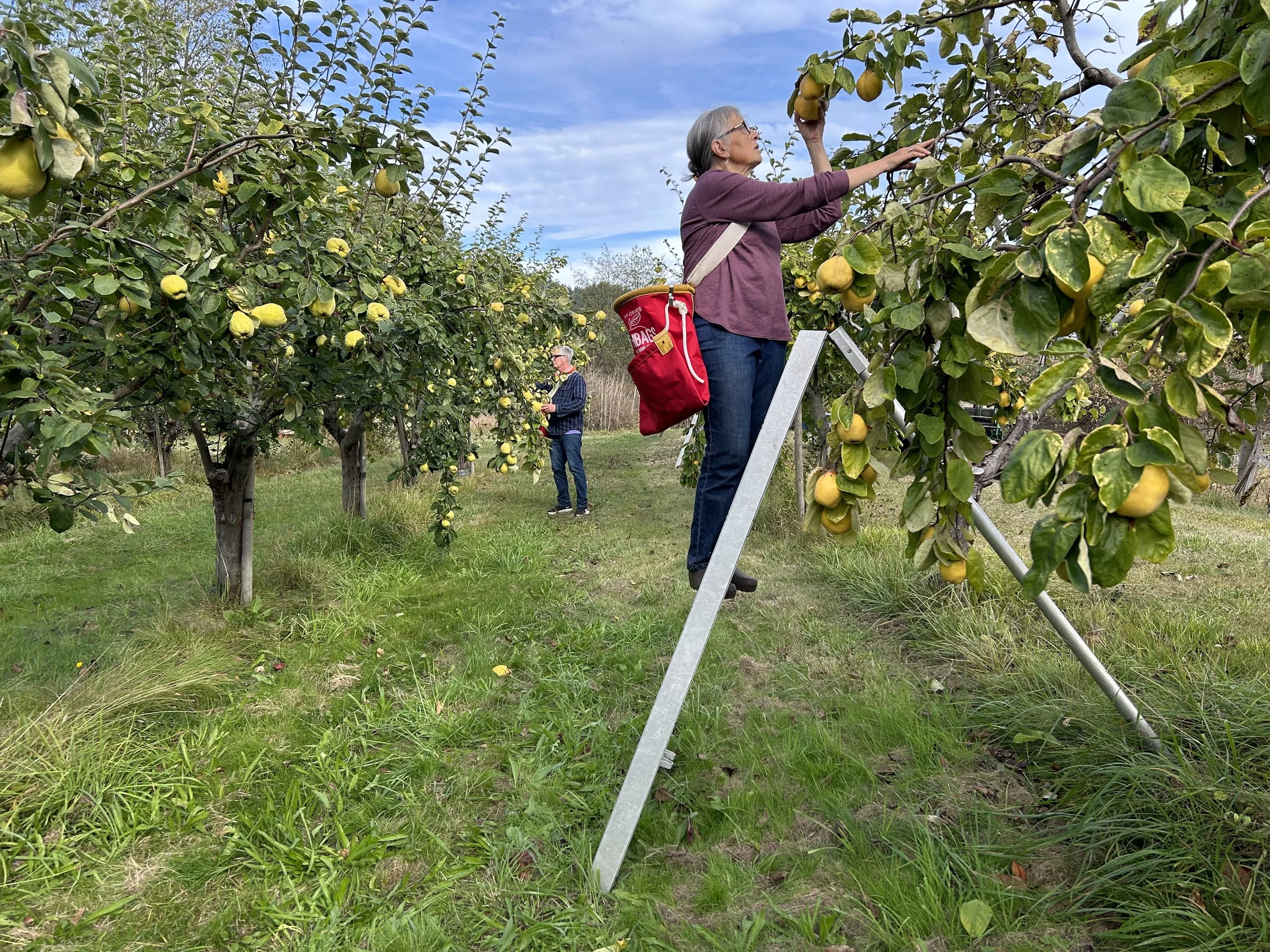Harvesting Gold: Quince Season at Willowrose Bay Farm
Quince, ready to pick (Photo: Bryony Angell)
Guemes Island isn’t known for farming. Tucked just across the channel from Anacortes in Skagit County, the island today is better associated with quiet woods, vacation homes, and the rhythms of the ferry that connects it to the mainland. Farming here is rare—logistically tricky, economically risky, and often solitary.
But amid the evergreens and shoreline, Willowrose Bay Farm stands as an exception.
Edith Walden, affectionately known among her customers as The Quince Queen, cultivates what she calls “odd fruit” on 25 acres overlooking the Dakota Creek Shipyard. As the creator and proprietor of the largest quince orchard in Washington state, Walden knows both the delights and the challenges of island farming.
On the mainland, Skagit County farmers enjoy access to agronomy services, feed stores, equipment sales and repairs, ditch and drainage districts, local and federal agencies—and the occasional coffee with other farmers. That’s not a given for island farmers.
Guemes has one small grocery store. Everything else—supplies, workers, tractors that can’t be fixed by a local, crops—must come and go by ferry. Even the bees that pollinate Walden’s trees are ferried in. The ferry doesn’t sail in rough weather, is replaced every other year by a passenger-only vessel for several weeks, and the fares only increase.
So, what are quince—and how did they end up on Guemes Island?
Edith Walden of Willowrose Bay Farm (Photo: Mary Lascelles)
Native to Iran and Azerbaijan, this ancient member of the rosaceae family hitchhiked around the world with people and goods. Once a staple on North American farms, quince were used for their high pectin content, helping set homemade preserves.
The fruit appears in poetry and song—like in “The Owl and the Pussycat,” they dined on mince, and slices of quince…and danced by the light of the moon. Some historians even believe it was a quince, not an apple, that tempted Eve in the Garden of Eden.
Quince are “green and ugly” until they are fully ripe, says Walden, when “they turn this beautiful gold color—like lanterns turning on. You can understand why Eve would’ve been attracted to them.”
Despite the romanticized backstory, growing and selling quince can be a trial.
Because they bloom in single blossoms rather than clusters, with no fragrance, “they don’t have as much going for them in terms of attracting pollinators,” says Walden.
And they’re not exactly appetizing raw—quince must be cooked to be enjoyed.
But when they are cooked—oh my.
“It’s one of those early fall treats that arrive just when we’ve exhausted our appetite for tomatoes and stone fruit,” says Holly Smith, chef at Café Juanita in Kirkland. “I covet Edith’s amazing quince.” Among Smith’s specialties: quince with lamb and a wild watercress salad dressed in quince vinegar reduction with a touch of porcini cream.
The orchard in October, just before harvest (Photo: Bryony Angell)
Still, quince can be a tough sell. By focusing on chefs like Smith, Whole Foods, local co-ops like the Skagit Valley Food Co-op, and cider makers like Eaglemount Wine and Cider of Port Townsend, Walden sidesteps one big barrier: educating the public about this little-known fruit.
“I really believe in quince,” says Walden. Creating and nurturing her Eden-like orchard has been a three-decade labor of love. Walden was the first director of the City of Seattle’s P-Patch program, Seattle’s iconic community gardening initiative, before moving to Guemes. In 1999, she planted 175 quince trees of 13 varieties well-suited to the island climate. She added pears, heirloom apples, and crabapples to help lure native bumblebees essential to spring pollination.
She used open-vase pruning for shapely, easy-to-harvest trees, built a pond for irrigation, fenced her orchard against deer, and constructed two large coolers—one just for quince, whose strong fragrance at maturity overwhelms other fruit. In nearby commercial kitchens, she’s made quince jelly, marmalade, spreads, and syrups.
Tom Thornton, co-founder of Cloud Mountain Farm Center, a nonprofit agricultural hub in Whatcom County, helped Walden get started. “Now I’m the research and development station,” she jokes. “There’s no one else in this area.”
Harvest begins in late September. In a good year, Walden and her crew gather up to 8,000 pounds of quince. In 2023, her best year yet, the orchard yielded 14,000 pounds.
Then came 2024. Just when blossoms appeared, a late cold snap sent bumblebees and honeybees back to their hives. Pollination was low. A severe infestation of tent caterpillars—worse than anyone on Guemes could recall—ravaged the orchard tree by tree, leaf by leaf. Then came black spot, a common fungal disease that blemishes otherwise perfectly tasty fruit. More than a ton of unripe quince dropped early and went straight to the compost heap. There was little left to sell.
Harvesting quince at Willowrose Bay Farm, Edith in the foreground (Photo: David Wertheimer)
This year looks better. The bees that took the ferry in 2025 did a great job pollinating, the trees show no signs of black spot, and tent caterpillars aren’t expected to return for seven to nine years.
Because quince trees can produce for a century, they will outlive Walden. High on her to-do list is finding someone equally passionate about her “odd fruit,” who is up for the adventure of island farming and eager to learn from an expert.
Whoever tends the orchard next will discover what the Quince Queen learned early on.
“Farming is about humility. So many things can go wrong, so many can go right, and so much is out of your control,” says Walden. “When Nature is in charge, you have to learn to adapt.”
Willowrose Bay quince is available locally at the Skagit Valley Food Co op when in season (October is harvest time; call ahead to make sure they are in stock). Edith’s recommended recipe for poaching quince can be found here.
Story by Anne Basye: info@skagitonians.org
Story updated October 2025 to include sourcing and recipe information.




